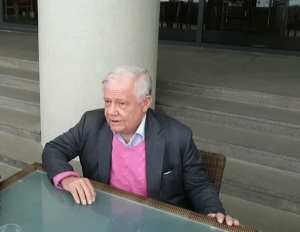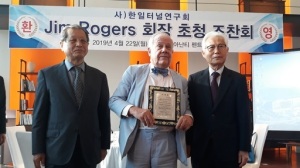
Chairman Jim Rogers is giving an explanation on the Korea-Japan Undersea Tunnel and why we should invest in unified South Korea and North Korea at Ananti Cove Penthouse in Gijang-gun, Busan on the morning of the 21st.
Jim Rogers (77), a global investment expert and chairman of Rogers Holdings, said this in an exclusive interview with Sekai Ilbo on the 21st at Ananti Cove Penthouse in Gijang-gun, Busan. .
The Korea-Japan Undersea Tunnel is being promoted by the Korea-Japan Tunnel Research Association (co-representatives: Lee Yong-hum and Seo Eui-taek). It connects Busan and Geoje Island, via Tsushima, and Karatsu City, Saga Prefecture, Kyushu, Japan. The total length is 209-231km (128-145km undersea section). Rather than connecting the entire tunnel with one large tunnel, it is characterized by connecting smaller tunnels created in sections for each stopover. This peace project began in November 1981 when Sun Myung Moon, president of the Family Federation for World Peace and Unification, advocated the ``International Highway'' plan at the 10th International Conference on Scientific Unity (ICUS). Since then, Hak Ja Han, president of the Family Federation, has continued to promote this project as part of the construction of the ``Peace Road,'' a world peace expressway. Construction of an undersea tunnel is estimated to take 10 to 15 years and cost between 62 trillion won and 100 trillion won.
Chairman Rogers believes that after unification, the Korean Peninsula will play a role as an important hub for global transportation and logistics. If the North and South railways are connected through the Donghae Line and the Seohae Line, they will be connected not only to China and Russia, but also to Europe. He emphasized, ``If the Korea-Japan Undersea Tunnel is opened, it will be possible to travel by land from Tokyo, Japan to Berlin, Germany. That alone will create enormous economic value.'' He added, ``(A unified Korea) would not only be a blessing from Japan's perspective.I also think that it would be difficult for Japan to compete with a unified Korea.''

Chairman Jim Rogers was appointed as an advisor to the Korea-Japan Tunnel Study Group on the morning of the 22nd at the Ananti Cove Penthouse in Gijang-gun, Busan. From the left: Lee Young-hum, co-representative of the Korea-Japan Tunnel Research Group, Chairman Jim Rogers, and Seo Wie-taek, co-representative of the Korea-Japan Tunnel Research Group. (Courtesy of the Korea-Japan Tunnel Research Group)
Chairman Rogers predicted that the tourism industry would grow significantly, especially in a ``unified Korea.'' He said, ``North Korea did not develop in terms of tourism for several decades, and during that time it was not open to the public. Also, people in the United States and Europe did not consider South Korea as a tourist destination.'' Many people will be racing to visit South and North Korea first." At the same time, he predicted, ``A unified Korea will become the most interesting country in the world.''
Chairman Rogers said, ``North Korea has a cheap and educated labor force, as well as a rich natural environment and underground resources, but it has not developed to the extent that they can fully utilize these resources.South Korea has no capital and production facilities. ``As more investments are made in the Korean peninsula, it will become geopolitically important,'' he said. He also reiterated, ``This is not something the Korean people would be happy to hear. Over the next 10 to 20 years, the Korean Peninsula will become the most interesting and dynamic place in the world.''
He said, ``I don't think the world economy will improve in a year or two, but the Korean peninsula will not be affected much by such predictions.'' He added, ``If inter-Korean exchanges begin, there will be more economic benefits.'' He predicted that this would lead to countless investments and prosperity. Korea now has an opportunity to ``make good things even better.''
Chairman Rogers, who has announced his intention to actively invest in North Korea for several years, said, ``It is difficult to predict when South Korea and North Korea will be reunified. ``It is possible that things could change suddenly like a fire,'' he said, adding, ``I am convinced that the era of such a ``unified Korea'' will come.''
On the 22nd, he was appointed as an honorary advisor to the Korea-Japan Tunnel Study Group. He also received an honorary doctorate degree from Busan National University for his contributions to creating an atmosphere of peace on the Korean peninsula. It is said that the reason he received a doctorate in philosophy rather than business administration or economics was due to his deep interest and knowledge of history and philosophy. Chairman Rogers received a bachelor's degree in history (1964) from Yale University before receiving a bachelor's degree in economics (1966) from Oxford University. After his degree ceremony, he gave a special lecture to students on the theme of ``Unification and the Future of the Korean Peninsula,'' and in the afternoon of the same day, at the invitation of BNK Busan Bank, he gave a lecture on the same topic at the Busan Bank headquarters.
◆Chairman Jim Rogers is considered one of the world's three largest investors, along with Warren Buffett and George Soros. Born in Alabama, USA, he is famous for his first business as a child, selling peanuts and collecting empty bottles from baseball stadiums. After studying history at Yale University in the United States and philosophy, politics, and economics at Balliol College, Oxford University, he worked on Wall Street. He established the hedge fund Quantum Fund with George Soros and achieved an astonishing return of 4,200% over 10 years, making him famous as a global investor. After leaving Quantum Fund, he successfully traveled around the world three times and became an adventurer. Chairman Rogers, who moved to Singapore after selling his home in New York in 2007, focused on the value of Asia. In 2014, he made headlines when he announced at an investment briefing in the UK that he would like to invest all his assets in North Korea.
Busan = Reporter Lee Bo-ram
This is a Japanese translation of the original Korean text from Sekai Ilbo on April 22, 2019.
Jim Rogers, “Korea-Japan submarine tunnel is a big project for a unified Korean peninsula.”
You can download the original Korean text PDF above from here.
